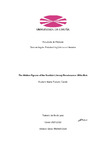The Hidden Figures of the Scottish Literary Renaissance: Willa Muir
Title
The Hidden Figures of the Scottish Literary Renaissance: Willa MuirAuthor(s)
Directors
Clark, David M.Date
2022Center/Dept./Entity
Universidade da Coruña. Facultade de FiloloxíaDescription
Traballo fin de grao (UDC.FIL). Inglés: estudios lingüísticos y literarios. Curso 2021/2022Abstract
[Abstract] The objective of this paper is the analysis of Willa Muir as a Scottish woman and as a
writer, and how she is framed within the Scottish Literary Renaissance, which was a
progressive tendency that reached its peak in the interwar period. We also aim to
exhibit the importance that female figures had in this literary movement, highlighting
Willa Muir.
The methodology used was, firstly, that of bibliographical research, and, secondly, a
close reading of the two chosen texts: “Women: An Inquiry” (1925) and Imagined
Corners (1931). We analysed the main characteristics and repertoires of these works
in an attempt to accurately assess Muir’s contribution to Scottish literature. This
paper’s introduction provides the essential information on the literary movement and
on the author’s life and work. Bearing in mind the characteristics of the movement, we
highlight Willa Muir as she represents a key figure (due to her translations and her own
contributions) of the Scottish Renaissance that has been hidden because of her
gender identity.
The main sections of this paper analyse on the one hand the Scottish Literary
Renaissance (its characteristics, its aims, the historical and literary context, etc) and
the role of women within this movement (the repression, the publishing conditions, and
the pressure they suffered), and on the other hand Muir’s life and work, focusing our
attention on two of her earliest literary productions.
Section number 2 is an overview on Scottish Literary Renaissance. We will discuss
how this movement was born as a reaction against the political and literary degradation
of the previous century, caused by the political union of Scotland and England, and
the use of outgrown literary forms such as the Kailyard and the Celtic Twilight. To solve this, many authors became politicians, and the translations of European contemporary
works became crucial. However, the movement was dominated by men, who
disregarded women’s literary production. As a result, since the 1990’s female scholars
are reappraising these women’s texts, at least those that have been transmitted.
Section number 3 focuses on Willa Muir, first on her biography and then on her works.
Muir’s life greatly affects her books, so we will look into her life, demonstrating the
veracity of that statement, her linguistic competence and her progressive views on
topics such as motherhood, equality, and women’s creativity. First, we will do an
analysis on her first essay “Women: An Inquiry”, which has not caught the 21st century
attention due to her dated views on feminism and its contradictions. However, this
piece is vital to understand her later productions, as it presents ideas that she will
explore in her novels. Second, we will study Imagined Corners, Muir’s first novel and
an exploration of the feminist thesis presented on her previous essay. This novel is
more successful than the book in its depiction of a new model of womanhood: a
woman who searches for her own worth outside of her role as a wife and/or mother.
However, its portrayal of Scotland reflects Muir’s resentment toward the patriarchal
society in which she grew up
Keywords
Muir, Willa
Scottish literary renaissance
Gender identity
Feminism
Scottish literary renaissance
Gender identity
Feminism
Rights
Os titulares dos dereitos de propiedade intelectual autorizan a visualización do contido deste traballo a través de Internet, así como a súa reproducción, gravación en soporte informático ou impresión para o seu uso privado e/ou con fins de estudo e de investigación. En nengún caso se permite o uso lucrativo deste documento. Estos dereitos afectan tanto ó resumo do traballo como o seu contido Los titulares de los derechos de propiedad intelectual autorizan la visualización del contenido de este trabajo a través de Internet, así como su repoducción, grabación en soporte informático o impresión para su uso privado o con fines de investigación. En ningún caso se permite el uso lucrativo de este documento. Estos derechos afectan tanto al resumen del trabajo como a su contenido






